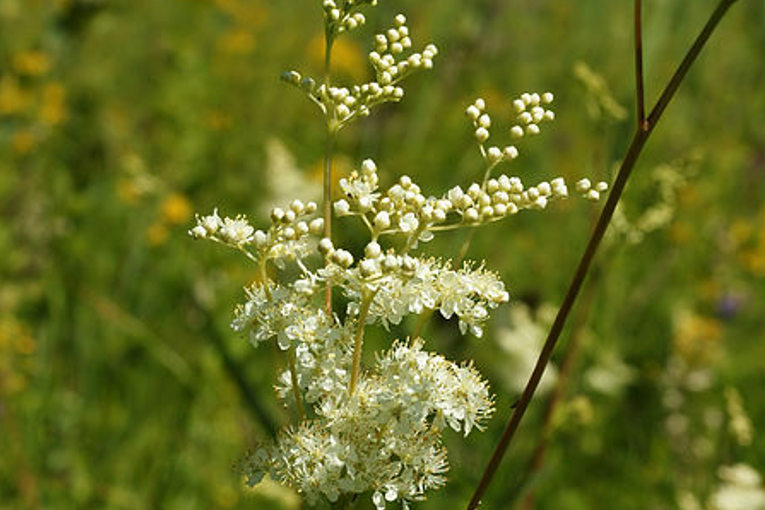Every August the boglands and canal-banks of County Kildare erupt in yellowish tufts of meadowsweet, filling the breeze with their sweet scent. For centuries it was used as a painkiller, as it contains salicylic acid, the basis of aspirin – in fact, its Latin name Spiraea is how we got the word “aspirin.” Irish also used its strong aroma to freshen their houses, as well as to flavour mead – the name means “mead sweet.”
To use meadowsweet you have to pick it first, taking the tufty flower off the top. Unlike some wildflowers, meadowsweet are in no danger of going extinct, and have only multiplied with human activity. It grows along roadsides, but don’t pick it from there – you don’t want the chemicals from the car exhaust.
Meadowsweet makes a good tea, slightly astringent and very aromatic. You can also pick 20 or so meadowsweet flowers to make a sweet cordial, which can be kept for years and used to flavour drinks or in cooking. Heat 750 ml of water and stir in 400g of sugar and 20 ml of lemon juice. Bring to a boil and add the meadowsweet, then turn off the heat and wait about 10 minutes before straining the liquid. Let it cool and store in the refrigerator.
Most of all, meadowsweet makes a delicious dry wine. These days, for many Westerners, “wine” refers only to grape wine, but you can make wine and beer from almost any edible plant and some inedible ones. Turning water into wine – literally – could be a matter of life and death for most of human history. Water could be contaminated with any number of diseases, but adding vegetable matter and yeast allowed the yeast to multiply and take over, releasing enough alcohol to discourage any other life in the water.
Making the wine is similar to making the cordial, with the addition of yeast and time. Pour six litres of water into a large pot, and bring it to a boil. Then dump in two litres of meadowsweet tufts. Squeeze in the juice of two lemons, boil it again, and turn the heat off – I also put in the zest of the lemons to make it a bit tarter.
Stir in a kilogram of sugar slowly until it dissolves, and waited for the liquid to cool to blood temperature. Then pour it into a cleaned and sterilised bucket and add wine yeast – although bread yeast will do in a pinch — and cover the bucket and set it in the closet.
Over the next week check the bucket periodically; it should be bubbling away slowly as the yeast turns sugar into alcohol and carbon dioxide. After a week or so, sterilise a carboy – a large jug with an S-shaped valve on the top – and strain the wine into it; I use a paper coffee filter to strain it into a large glass, and then pour it through a funnel into the carboy. Carboys let you store wine during the weeks or months that it still might build up some air pressure, before you pour it into conventional wine bottles.
After pouring the wine into the carboy, you will have some leftover vegetable matter, and you could compost them, feed them to chickens or – as I did – combine them with apple peelings and make them into jam.
No home-made wine will taste like store-bought wine, but most people think it tastes better. Try mixing them with juice and water at first, or store-bought white wine, to make a punch, to acclimatise yourself to the taste of home-made. If it doesn’t turn out, you can do what I did and make the bad wine into vinegar.
Some medical authorities caution against women taking meadowsweet when they are pregnant, thinking that its aspirin-like properties could be harmful in large doses – but you should avoid drinking wine then anyway.






